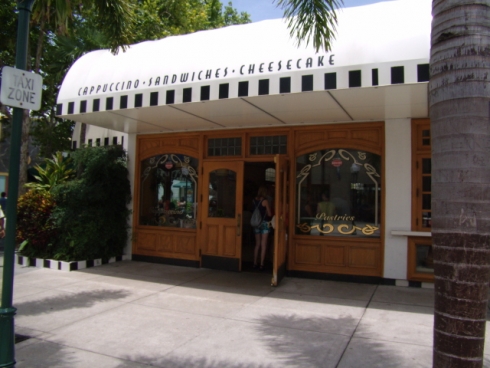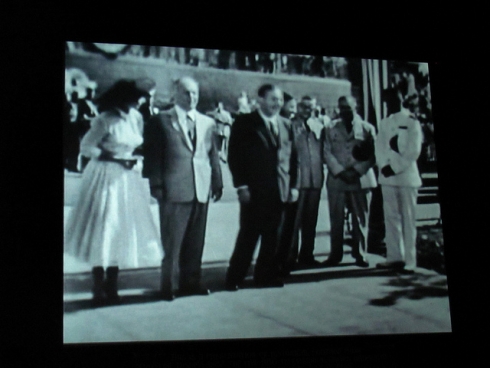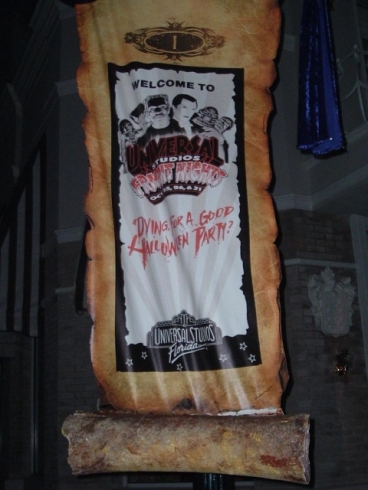4. Food and beverage issues
 BoulangerieThe Boulangerie, like the rest of Universal's restaurants, had a line out the door.
BoulangerieThe Boulangerie, like the rest of Universal's restaurants, had a line out the door.
Disneyland fell victim to a plumbers’ strike that forced Walt to choose between restrooms and water fountains. He chose restrooms, leaving guests to pay for sodas to quench their thirst in a Southern California heat wave. The sheer number of unexpected visitors and the unavailability of water fountains led to long lines of frustrated people at the park’s eateries.
Universal Studios Florida had plenty of water fountains and plenty of food, but not enough to do. As the crowds swelled throughout the day, the ride problems continued to worsen. Tired of waiting for the headliners to open, many people went in search of a good meal. Food service lines grew longer and longer, adding another layer of frustration to an already difficult day.
5. Compensation
 Disneyland Opening GalaWalt Disney compensated his visitors for their difficulties by offering them a second day free. Image: Loren Javier, Flickr
Disneyland Opening GalaWalt Disney compensated his visitors for their difficulties by offering them a second day free. Image: Loren Javier, Flickr
Both Disneyland’s and Universal Studios Florida’s opening days were declared unmitigated disasters by many of those who attended. They felt duped, frustrated and angry, and they were happy to make their feelings known. At Disneyland, the guests had not paid for admission. They were there as invited guests. Nonetheless, Walt Disney felt they deserved some compensation for the hassles. He invited everyone to return for a second day at a later time, also as his personal guests.
Universal Studios Florida’s visitors had paid for their admission, and they wasted no time in storming Guest Services with their complaints. The company quietly began issuing no-questions-asked refunds to anyone who wanted one. Hedging their bets for the future, they also implemented a second day free offer that lasted through the busy summer season.
6. The little park that could
 Fright NightsFright Nights, now Halloween Horror Nights, helped turn Universal's fortunes around.
Fright NightsFright Nights, now Halloween Horror Nights, helped turn Universal's fortunes around.
It seemed certain that Disneyland would fail. Experts talked at length about how this unproven concept, which was stretched beyond its limits by the crowds, could never be profitable. The public generally agreed that even the beloved Walt Disney was a fallible human being who had simply bitten off more than he could chew.
Yet despite all odds, Disneyland began to flourish. Walt learned from his mistakes, soon capping daily attendance at 20,000 to avoid overcrowding. Through a great deal of trial and error, the company learned what worked and what didn’t when it came to pushing that many people through attractions each day. Word of mouth spread that the problems were being fixed and the dream was shining through. Just seven weeks after that disastrous opening day, Disneyland welcomed its millionth guest.
Of course, that was only the beginning. Under Walt’s leadership, the Florida Project was born. Although he did not live to see its completion, the 1971 opening of the Magic Kingdom in Florida touched off an era of expansion that has gone global. Disney became the clear leader of the theme park industry, proving once and for all that clean, safe, heavily themed parks have a timeless appeal that cuts across cultural barriers.
While Disneyland’s future was far from assured, it had both novelty and the charisma of Walt Disney behind it. Universal Studios Florida had neither. In Central Florida, Disney was clearly king, and smaller parks such as SeaWorld Orlando were there to siphon some spending from Disney guests. How could Universal possibly hope to overcome its black eye and convince people to try it again?
The road was not easy, but parent company MCA persevered. They went to the source to fix the rides’ technical problems, filing lawsuits against ride designers and insisting that the attractions be tweaked to perfection. This heavily-publicized approach reassured the public that the company was focused on making things right. Meanwhile, the entire Universal Studios Florida staff pulled together as a team. They believed in their park and were determined to do whatever they could to make it better. Ride operators memorized technical manuals in order to work with the techs to troubleshoot problems. Managers filled in at overcrowded food service locations and even took janitorial shifts.
As the 1991 summer tourist season began, things were guardedly optimistic for the Little Park That Could. Two of the three headliners were out of technical rehearsals and operating regularly, and new smaller attractions were dispersing the crowds. But it was that fall when Universal’s fortunes finally changed for good, via a little three-night party known as Fright Nights.
Fright Nights gave locals and visitors a place to celebrate Halloween with heavily discounted admission, live stage shows, wandering scareactors and a walk-through haunted house. An instant success, it returned the next year as Halloween Horror Nights. That annual event helped turn around Universal’s reputation, solidifying it as a vacation destination. In 1999, Universal opened its second park, Islands of Adventure, transforming itself into a multi-day experience.
Although the theme park wars seemed lost before they began, Universal Orlando continues to prove that there is room for two powerhouses in the Central Florida market. Iron sharpens iron, and the competition keeps both destinations on their toes. As a result, the future looks brighter than ever for theme park fans.
Add new comment